"Upon contemplating the baroque of the churches
and the glare of the gold, the visitor looking
does not merge the building with the past: small hills
so dark: and does not grasp the silence
of a totem never seen.
The baroque is not the depletion of the gold
but the right of the raped body."
Edimilson de Almeida Pereira -Ouro Preto -[interpretation itinerary]
display
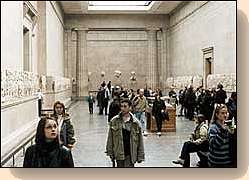 At present the
British Parthenon sculptures are in the Duveen gallery at the British Museum,
the Greek ones in the Acropolis Museum and Acropolis Studies Centre, with a
few small fragment in other locations. The Duveen Gallery replaces the previous
Elgin Room at the British Museum and as such was a space designed with the specific
and sole intention of displaying the marbles. Since the marbles have been in
the Duveen Gallery, they have been reorganised once, during a major refit of
the gallery and it is this layout that we will now focus on. On first glance
the sculptures all appear to be well displayed, There is not only room to stand
back and get an overall view, but as the sculptures are all at eye level, you
can get as close to them as you want and examine even the minutest detail. The
Pediment sculptures are on a plinth that allows your to circulate around them
and everything is well lit so that there are no harsh shadows. There are however
many unrecognised problems with this arrangement.
At present the
British Parthenon sculptures are in the Duveen gallery at the British Museum,
the Greek ones in the Acropolis Museum and Acropolis Studies Centre, with a
few small fragment in other locations. The Duveen Gallery replaces the previous
Elgin Room at the British Museum and as such was a space designed with the specific
and sole intention of displaying the marbles. Since the marbles have been in
the Duveen Gallery, they have been reorganised once, during a major refit of
the gallery and it is this layout that we will now focus on. On first glance
the sculptures all appear to be well displayed, There is not only room to stand
back and get an overall view, but as the sculptures are all at eye level, you
can get as close to them as you want and examine even the minutest detail. The
Pediment sculptures are on a plinth that allows your to circulate around them
and everything is well lit so that there are no harsh shadows. There are however
many unrecognised problems with this arrangement.
arrangement
The Frieze, of which the British Museum owns more than half, is arranged along
the two long walls of the gallery. The east frieze is central to one wall, directly
opposite the entrance to the gallery. Because of this location however, the
north and south friezes are both broken into two portions on either wall of
the gallery, with the fragments of the west frieze on one side of the entrance.
The frieze as a whole, although arranged in order, is completely inverted so
that it faces inwards rather than outwards. Consequently it is all visible from
any point in the central gallery and thus each side of it is treated equally.
There is no way that you could possibly believe the frieze was obscured or a
secret in this location.
The metopes in the British Museum, all of which come from the south side, are
arranged in four locations in opposite corners of the gallery. No matter how
simple the story in them might have been, it is impossible to follow when they
are arranged in this way, because in moving between the four groups you feel
obliged to glance at any other sculptures you pass en route. Any discussion
of whether they are arranged in the correct order is rendered irrelevant until
they are first arranged in any order.
The pediment sculptures are at either end of the gallery, facing the centre
of the space. The plinth they sit on is compressed for reasons of space, but
this is not too much of a problem because so many of the central figures are
missing. It does however make it hard to get an idea of the true scale and the
number of figures that should be present.
Many of the sculptures are either still in Athens or lost and where frieze panels
are missing, the intervening ones are just ignored and no attempt is made to
represent the figures that are missing from the procession. Two panels once
separated by five others in between now butt together, pretending to still be
part of a continuous story. In some of the panels, this is obvious as figures
are broken at the join, but in other panels the discrepancy can only be seen
by carefully following the figure numbering sequence on the information plates
beneath.
viewing
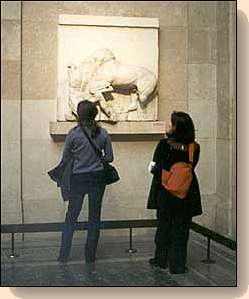 Nowhere in the
British Museum's exoteric arrangement is there any implication of hierarchy,
all elements are treated equally and all are instantly visible. No longer is
the temple central, it is now the viewer who is central to the arrangement.
There is not even the slightest hint of any form of hierarchy within the arrangement,
and nothing is revealed as you move through the space. No mention is made of
the original existence of a central statue of Athena and no attempt is made
to create a linear flow through the sculptures.
Nowhere in the
British Museum's exoteric arrangement is there any implication of hierarchy,
all elements are treated equally and all are instantly visible. No longer is
the temple central, it is now the viewer who is central to the arrangement.
There is not even the slightest hint of any form of hierarchy within the arrangement,
and nothing is revealed as you move through the space. No mention is made of
the original existence of a central statue of Athena and no attempt is made
to create a linear flow through the sculptures.
Not only is the hierarchy and layering gone, but just as importantly the viewing
angle has changed. Whereas once the sculptures were intended to be seen both
from a great distance and from a vantage point far below, it is now only possible
to view them from eye level. The frieze that was carefully carved so as to display
the figures correctly from below is now seen flat on. Even if you want to try
and see it from the original angle by lying on the floor, the required vantage
point is impossible to achieve due to the security rails at ground level. If
you could manage to get the same angle, the effect would still be lost through
parallax, as the perspective from two metres away presents an entirely different
picture from that of fifty metres. The frieze is presented in a way that it
could never have been seen originally and it is impossible to even get close
to the original viewing angle. A similar problem occurs when trying to view
the metopes and pediments, although here it is of marginally less consequence
than in the frieze as from their original location on the outside of the building
they could have been seen from a much flatter angle.
lighting
"High noon. The light falls vertically, this is the most Greek of hours.
The perfect classic. A little later the dusk will bring romantic shadows, will
envelop the pure, severe, nudity of the Greek earth in chiaroscuro effects,
and break the steady, certain lines. This meridian sun is the true ancient Greek.
Dusk, the night and the moon all belong to the sorceresses of Thessaly and Thrace,
and to far northern romantics." Nikos Kazantzakis
-Travels in Greece
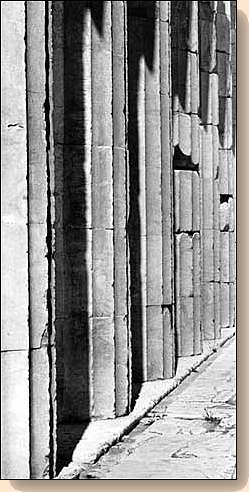 The Greek sun
could be seen as one of the governing features in our perception of the architecture
there. The deep shadows it creates contrast with the pale austerity and geometry
of the buildings. The play of light on and through the columns of a temple echoes
the building's organic origins, it is the edge of a forest with shafts of sun
breaking through the tree trunks. It is as integral a part of the architecture
and sense of place as the physical context surrounding the building.
The Greek sun
could be seen as one of the governing features in our perception of the architecture
there. The deep shadows it creates contrast with the pale austerity and geometry
of the buildings. The play of light on and through the columns of a temple echoes
the building's organic origins, it is the edge of a forest with shafts of sun
breaking through the tree trunks. It is as integral a part of the architecture
and sense of place as the physical context surrounding the building.
In the Duveen Gallery, in order to allow clear viewing of the sculptures, large
translucent panels allow diffuse daylight to evenly illuminate the entire space
supplemented by spotlights with coloured filters. There are only the vaguest
hints of shadows in the deepest recesses of the sculptures and you can not tell
how distorted the colours are becoming through the tinted light. Again, the
original viewing framework is forgotten and lost in the Museum's struggle for
exotericity.
Perhaps the most crucial element as regards lighting, is again the frieze. Originally
recessed behind the beam supporting the metopes, it would have only received
illumination from diffuse sunlight reflected up from the marble walls and the
ground around the building. Other parts behind columns would have been deeper
in shadow, almost a mystical half image fading in and out like a dream. In the
Duveen Gallery however, the frieze still receives the same light from above
as the other sculptures. There is no attempt to create a contrast between the
harsh and the subtle, the light and the subfusc as there was on the original
building.
explanation
Even if we assume that all the above arguments are negated by the limited space
in the British Museum and that the marbles are currently displayed by them in
the best possible way, there is still another opportunity that has been lost
by them. As people's concepts of galleries and museums have changed, so the
British Museum has subtly altered the modes of display. Additional information
galleries have been added in the space preceding the entrance of the Duveen
Gallery and these serve the admirable purpose of explaining to people something
about the marbles before they enter the main gallery. Amongst other things,
are larger information boards, a copy of a metope on a corner with triglyphs
around it and a capital beneath it, touchable copies of the marbles for the
blind and various smaller finds from the site.
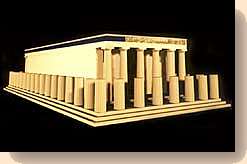 The most impressive
feature of these new galleries is a video showing a computerised reconstruction
of the Parthenon on a large screen. The computer model is executed to a meticulous
level of detail and its aim is to illustrate and explain features of the Parthenon
and its sculptures that are not obvious in the main gallery. Amongst other things
it shows how the sculptures would have been coloured originally, how the metopes
slotted into the triglyphs, how the horsemen were arranged in ranks and how
the pediment sculptures are carved in the round. The video was the perfect opportunity
to explain and illustrate the shortcomings just discussed, the hierarchy, viewing
angle and application of movement.
The most impressive
feature of these new galleries is a video showing a computerised reconstruction
of the Parthenon on a large screen. The computer model is executed to a meticulous
level of detail and its aim is to illustrate and explain features of the Parthenon
and its sculptures that are not obvious in the main gallery. Amongst other things
it shows how the sculptures would have been coloured originally, how the metopes
slotted into the triglyphs, how the horsemen were arranged in ranks and how
the pediment sculptures are carved in the round. The video was the perfect opportunity
to explain and illustrate the shortcomings just discussed, the hierarchy, viewing
angle and application of movement.
Instead of showing any of these features, the British Museum's video is entirely
context free, with the building drifting in a black abyss without even a ground
plane to relate to. Nowhere is there any suggestion of the importance of the
context to the building, the route leading to the building, the idea of a procession.
Every side of the building is equal and its orientation is only identifiable
from closely examining the images on the pediments. To make matters worse however,
the video doesn't at any point present the viewer with a human perspective of
the building. There is never a stage where you are on the ground looking up
at it. Instead the viewer floats level with the middle of the columns, watching
the building rotate in front of them and occasionally zooming in to specific
details. The building is never explained.
new museum
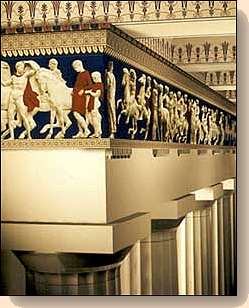 At present, Athens
is in the process of constructing a new Acropolis Museum, close to the Parthenon
site at a location specifically chosen because its galleries would allow views
to the Parthenon at the same time as seeing the sculptures. Building work was
underway but halted due to important archaeological finds on the site. A new
competition has just been announced, for a similar site adjacent to the existing
one and practices from around the world have been invited to submit schemes.
At present, Athens
is in the process of constructing a new Acropolis Museum, close to the Parthenon
site at a location specifically chosen because its galleries would allow views
to the Parthenon at the same time as seeing the sculptures. Building work was
underway but halted due to important archaeological finds on the site. A new
competition has just been announced, for a similar site adjacent to the existing
one and practices from around the world have been invited to submit schemes.
After the lessons learned from the Duveen Gallery, one might hope that the new
gallery would be able to display the sculptures in a more accurate way. Many
of the proposals from the previous competition had interesting ideas about showing
the building and the marbles simultaneously, while all the schemes had the advantage
of not only having the complete collection, but also being within walking distance
of the Parthenon itself and thereby allowing a certain relevance of context.
Unfortunately though, only a small proportion of the 484 drawings submitted
for the previous competition showed more than a hint of understanding of the
concepts alluded to. Still more of the schemes, although outwardly appearing
to have developed a better comprehension of the relationship between the viewer
and the sculptures, on closer examination appeared to be merely blind emulations
of the Acropolis form, created with little knowledge of the reasoning behind
what was being done. Some entries did display a better understanding of the
sculptures and the parameters required for their display, but these submissions
were easily lost amidst the grand architectural statements by people wanting
to make their own mark on the city, creating buildings that would incidentally
house the sculptures as though this aspect was just an insignificant postscript
to the main design process.
conclusions
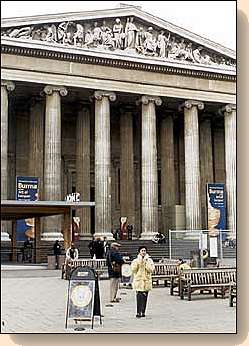 The problems
just described are just one example of how the meaning of the Parthenon Marbles
is completely lost to the casual visitor. Not only are the visitors uninterested,
but the information and contextual viewing framework that are required for understanding
are not there even if someone does want to know more.
The problems
just described are just one example of how the meaning of the Parthenon Marbles
is completely lost to the casual visitor. Not only are the visitors uninterested,
but the information and contextual viewing framework that are required for understanding
are not there even if someone does want to know more.
The Elgin Marbles are famous for being famous, people now merely want to see
them because they are famous, because they have heard of them and think that
through this they know what they are. One should however at this point be aware
that this problem is not one specific to the Marbles, but one that affects museums
and galleries in general. When people visit the British Museum they don't want
to see the objects inside, they want to say that they have been there. Even
the annual sales figures from the British Museum's own shop reflect this. After
the best selling card that depicts the Rosetta Stone (another lost meaning surely)
the next two most popular cards are one of the exterior of the museum by day
and one of it floodlit at night.
Merely saying the Elgin Marbles are famous for being famous only hints at the
problem. What has happened is that through continual cultural exposure, the
stones have become highly esteemed in people's eyes. While people might believe
that this reverence for a national treasure is a love of the actual object itself,
the more they consider the object, the more they lose sight of it.
Originally created by the Greeks after the Persian War as a symbol of triumph
,they were highly expressive of society then. Religious, political and artistic
contexts have since altered however and the sculptures no longer hold the same
direct relevance to us as they did to the ancient Greeks. Despite the fact that
their relevance is no longer present we still try to grasp at it, to build ourselves
a culture on a misunderstood past and in doing so we end up more confused.
totemism
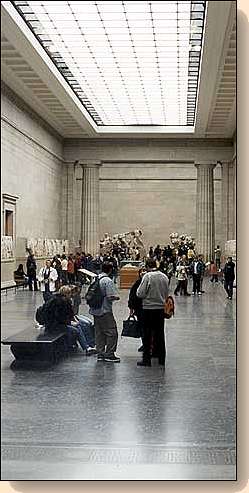 Unlike many
other ancient civilisations and their monuments the spirit of classical
Greece is not completely lost. Whilst increasing its importance, this
acts as an argument for revering the stones further, in the belief that
they themselves are the birth of our civilisation. Unlike the pyramids
of ancient Egypt that originated in a different continent, under an extinct
culture and were the product of slavery and the deification of a single
dictator, we see links between the Parthenon and our world today. Rather
than a monument to slavery and self gratification, the Parthenon has come
to symbolise democracy and freedom, the populace working towards a common
goal and it is that aspect that we identify with today.
Unlike many
other ancient civilisations and their monuments the spirit of classical
Greece is not completely lost. Whilst increasing its importance, this
acts as an argument for revering the stones further, in the belief that
they themselves are the birth of our civilisation. Unlike the pyramids
of ancient Egypt that originated in a different continent, under an extinct
culture and were the product of slavery and the deification of a single
dictator, we see links between the Parthenon and our world today. Rather
than a monument to slavery and self gratification, the Parthenon has come
to symbolise democracy and freedom, the populace working towards a common
goal and it is that aspect that we identify with today.
Whilst ideas from the time of Pericles continue to carry through our culture,
we will continue to iconify the monuments as being our origins, neglecting that
their relevance has been allowed to shift away from today and remain in the
past. Like so many national treasures, the Elgin Marbles have become revered
to a level completely out of proportion with their actual value. At the same
time this reverence from some attracts even greater reverence from their followers.
The Elgin Marbles are now a mere totem, an item of symbolic value that is sought
after yet the reason is obscured. To the public, any true meaning is now lost.
To those who want to appreciate them and understand their true worth, it is
impossible due to the hordes that rush past in attempt to tick them off the
list.
FOOTNOTE: Since this was written a new design for the Acropolis Museum has been
accepted by the Greek government. In private correspondence with me Matthew
Taylor has expressed the opinion that the new design proposed for the Acropolis
Museum now shows a far greater degree of understanding of the Parthenon than
any of the short-listed designs in the previous competition.
To view part 3a click here.